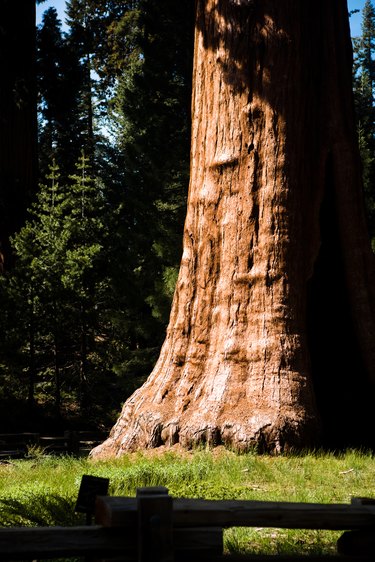
Evergreen trees maintain their foliage during every season of the year. In the Pacific Northwest, many of the region's evergreen trees are gymnosperms, meaning they rely on cones to disperse their seeds. Most Pacific Northwest evergreens have needles and grow between 40 and 100 feet tall when fully mature.
Firs
Video of the Day
Two groups of fir trees exist in the Pacific Northwest: Douglas firs and true firs. True fir cones are erect, while Douglas firs have cones pointing downward. Douglas firs have pitchfork-shaped bracts emerging from the cones. Both fir types have 1 inch long needles on their branches. The Douglas fir is Oregon's state tree.
Video of the Day
Pacific Yew
The only yew tree native to the Pacific Northwest is the Pacific yew. These trees feature pointy needles and small, red berries on their branches. This tree's range reaches from Northern California to British Columbia's coastal range. Pacific yew bark has a purple color with scaly texture. These trees grow between 20 and 40 feet tall.
Sequoias
The redwood and giant sequoia are Pacific Northwest natives. Although similar in appearance, the redwood belongs to the Sequoia genus and giant sequoia is from the Sequoiadendron genus. The giant sequoia is one of the tallest trees in the world, growing up to 280 feet tall. These trees are only native to Northern California.
Cedars
The Pacific Northwest is home to two cedar types: true cedars and false cedars. No true cedars are native to the Pacific Northwest, but the Middle East and East Asia. However, three species, Atlas, cedars of Lebanon and deodar, were introduced to the Pacific Northwest. False cedars, such as white- and incense cedar, have traits similar to true cedars. True and false cedars are aromatic and the cones remain on the trees after dispersing seeds.
Spruces
Brewer, Engelmann and Sitka spruces are Pacific Northwest natives. Spruces have cones and bark with scaly, flaky textures. Sitkas are found along the Pacific Northwest coastline, while Engelmann resides in Washington's Cascade Mountains. The rarest Pacific Northwest spruce, Brewer, is found in southern Oregon and Northern California.
Alders
Their egg-shaped leaves and 1-inch long cones identify alders. Four alder species are in the Pacific Northwest: red, white, Sitka and thinleaf. Thinleaf and Sitka alders have multiple trunks and do not grow taller than 25 feet. Red and white alders have single trunks and grow between 40 and 80 feet tall.
Hemlocks
Droopy branches and needles less than 1 inch long are two of hemlock trees' main characteristics. The Pacific Northwest is home to two hemlocks: Western and mountain. Mountain hemlocks have blue-green needles, while Western hemlock needles are yellow-green. Hemlock cones range from 1 to 3 inches long.
Junipers
The juniper tree group has three species in the Pacific Northwest: Rocky Mountain, Western and common. Upon maturity, Pacific Northwest juniper trees turn from green to blue. Junipers have red, berrylike fruit and their needles have prickly, sticky texture. These trees have a strong odor.
Pines
Pine trees have more species than any other evergreen tree in the Pacific Northwest at eight. The Pacific Northwest pines are lodgepole, whitebark, limber, sugar, knobcone, Ponderosa, Jeffrey and Western white. Different pine species are identified by the amount of needles in a bundle. Most pine species in the Pacific Northwest, such as Western white and sugar, have five needles per bundle.
- Colorado State University Extension; Evergreen Trees; R.A. Cox, et al.; April 2005
- Oregon State University: Common Trees of the Pacific Northwest - Douglas-Fir
- U.S. Forest Service: Pacific Yew
- Oregon State University: Common Trees of the Pacific Northwest - False Cedars
- Oregon State University: Common Trees of the Pacific Northwest - Alder
- U.S. Forest Service: Western Hemlock
- Oregon State University: Common Trees of Pacific Northwest - Juniper
- Oregon Magazine: Tree of the Month Archive